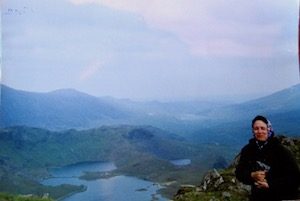
A very cold Nancy on The Crib Goch path on Mount Snowdon, Wales.
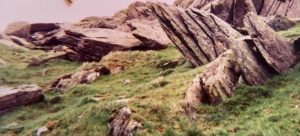
About 15 years ago, I tried to reach the summit of Mount Snowdown, Wales. It was such a challenging and memorable experience that I used it in A Nantucket Wedding.
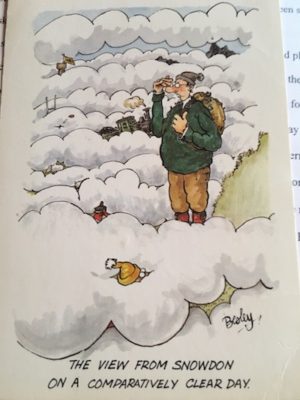
Because it is so near the sea, the mountain is visited by fogs, mists, and clouds of every possible shape and duration.
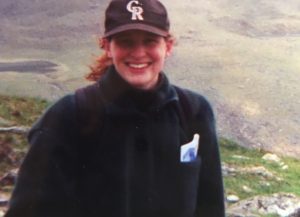
I couldn’t have done it without the company of my darling and brave daughter, Sam.
So when I got home, I did what writers do. I wrote about it. The following essay is about my climb on Mount Snowdon.
For me, the most memorable part is the following which I’ve excerpted for you all on Mother’s Day.
“I don’t think I can make it,” I told Sam.
“It looks pretty scary to me,” she said, but I knew she was just trying to make me feel better.
“We’re so close!” I wailed. Sam was radiantly beautiful standing there, her cheeks red with wind, her eyes gleaming, her figure slender, graceful, and strong. She was a goddess; I was a troll. “If it weren’t for me, you could make the summit!”
“If it weren’t for you, I wouldn’t be here,” she replied, grinning, and all at once I was flooded with joy.
These mountains were glorious beyond comprehension, but so was my daughter. While they hunkered down, dreaming their geological dreams, my daughter was here with me, with her great wide smile, her health, her laughter.
I smiled. “We’ll come back again,” I decided. “And we’ll do it right.”
How I Almost Climbed Mt. Snowdon in My “Princess” Reeboks
I’ve never been a jock, so I’ve been happily surprised as I’ve grown older to discover that the one thing I can do – walk – can be considered a kind of sport, and if I do it on a mountain, it’s called hiking.
I have a passion for the wild, romantic country of Wales, and a few years ago, when I first visited Snowdonia National Park with my husband, I gazed up at Mt. Snowdon and experienced an entirely new kind of desire.
I yearned to climb to the summit of Mt. Snowdon.
And the summer I was fifty-five I set out to do just that.
On the northwest coast of Wales, at 3,560 feet, Mt. Snowdon is the highest mountain south of Scotland in Great Britain, rising like the supreme jewel in a convoluted crown of peaks, ridges, valleys and lakes. To a novice like myself, it is not as forbidding as the Alps, yet still presents a serious challenge. To ascend it is to accomplish something serious; I envisioned myself proudly announcing: “I climbed to the top of Mt. Snowdon.”
Eons ago, volcanoes, glaciers, and upthrusts of the crust of the earth shaped this majestic pinwheel of peaks, ridges, valleys and lakes. Its five different paths vary in difficulty, but the upper reaches are slippery, steep, precipitous, and more often than not, shrouded in a mist that makes each step treacherous. Its Welsh name, ”Yr Wyddfa,” or “the great mound,” connotes the burial of a grand king or god, and one legend has it that King Arthur was killed and buried here. “Eryri,” the name the early Britons gave it, meant “home for eagles.”
My schedule made May the best month for me to travel. My husband couldn’t get away, so my 24-year-old daughter, Sam, a strong woman and an excellent hiker, agreed to accompany me. We flew to London, rented a car at Heathrow, drove to our hotel in Portmeirion, and bought, at the Browsers Bookshop in Porthmadog, various books on hiking and climbing in the area.
I prefer to walk in my featherweight sneakers, “Princess” Reeboks, with their wonderful arch support. Armed, or I should say, shod, with them, I primed myself, while we waited for the driest, sunniest day, with easier climbs: a three-mile walk over knolls sprinkled with blue bells, through a forest of twisting, fairy-tale trees on scenic Pen Morfa.
Finally, a warm, sunny day dawned. We ate a large, carbohydrate-high breakfast, packed Sam’s backpack with bottles of water and apples, and anticipated the changes in weather for which Mt. Snowdon is famous by wearing our oiled cloth raincoats.
We chose The Watkins Path. Driving deep into the mountains, we left our rented Rover 800 in a car park, crossed the road, went through a gate, over a bridge, and up a gentle slope, near farm buildings with their reassuring sense of domesticity. The ascent was slow and gradual, the path smooth and wide. We ambled, chatting, forgetting that we were climbing a mountain.
All at once, we discovered we’d entered a capacious valley that unfolded in a series of long, sloping, smooth shelves. Over the shelves, cutting down and down, spilled dozens of waterfalls, some so short that the water exploded back up into the air like fireworks, many plunging into wide clear pools of liquid light. These were not narrow falls hidden among gloomy ravines; these were wide, bright, and life-giving, lying open in the immense rolling valley. In some places the azure of the water was so intense I felt that we could dip our hands in and bring out clusters of jewels.
We were in the Nant Gwynant valley or, in Welsh, cwm, currently uninhabited, once someone’s home. At several places along the waterfalls were stony ruins of old houses, one so close to the thundering plunge of water that I couldn’t imagine how the inhabitants ever heard one another speak. The largest house had not, like all the others, merely succumbed to the ravages of neglect and time, but had been used as a practice target by Commandos training for D-Day. It stood in proud desolation, an open air shrine to the past.
The day was grand. We tramped along, exuberantly singing The Hills are Alive with the Sound of Music. The valley stretched out in all directions. The sun shone on rolling green hills grazed by sheep. Far on the left, high up on an alternative path, a long line of school children, just blots of bright primary colors, slowly wove toward the top of a ridge.
We didn’t seem to be going higher, the world just seemed to be getting wider, and I was surprised at how I huffed and puffed. Then I turned to glance back at the distance we’d covered, and realized that Mt. Snowdon was imbued with a rather Einsteinian quality, a sort of space-time warp in which the longer you hiked, the further the land expanded. We’d actually come a long way.
Finally, we arrived at an abandoned quarry. From here on, the path became rocky, shaly, and quite steep. It was slippery too, scattered with jagged knives and knobs of slate, not to mention slick black-green clumps of sheep droppings.
Sam trekked easily upward with a spring in her step, while I made slow progress. But that was fine. There was so much to see, why would I want to hurry? Perhaps it was that the geology of the land actually changed around here, or perhaps it was simply that I was taking the time to look, but now I saw clumps of glittering quartz imbedded in the shale and fabulous shapes like solidified lava flows. Every time I stopped to stare, the view had changed: the mountains, like enormous resting gods, had turned over in their sleep, so that at one spot I would see a bulge of shoulder, the next moment the heave of a hip, and the long winding knobs of a spine.
Slowly, but steadily, I climbed up and up, while above me, just around the corner, Sam called encouragement. The valley grew wider and steeper, the mountain walls loomed higher, closer, and all traces of humanity dwindled and disappeared, while the earth slept its profound, impersonal sleep. In the rolling hills caught between the higher walls of the mountains, green grass grew and lambs called to their mothers, but even they could not make the scenery appear tame. Here was height, steepness, and splendor on a grand scale. The mountains were here when volcanoes exploded, when seas flowed and evaporated, when the crust of the earth heaved and cracked and moaned. They’ve seen the big stuff happen. They know the secrets.
Inspired, I kept climbing. After three hours, I caught up with Sam. We sat for a while watching two men and an energetic dog stride toward us. When the men came abreast, we chatted; they told us that it would take about two more hours to reach the summit of Snowdon, because the last bit, which Sam and I could see, was precipitous, a true climb.
We weren’t discouraged. The day continued to be sunny and bright and we were both pretty euphoric at having gotten up as far as we had; we were looking down on mountain peaks! After a rest, determined, excited, we began to climb again.
The steepness increased. I was suffering from a bit of vertigo, as well as a general overwhelming existential panic at realizing how enormous the world is, all the time, while most of us aren’t even looking. We stood on one ridge, gazing out toward the southwest where, far in the distance, we could see the glitter of the ocean. We climbed some more.
At last we reached a major milestone: a col, a gap between mountain peaks from which we could look west to see Lake Cwellyn, to the east Lake Lydaw, and such a long expanse of valley that it seemed I was looking through a magic window back to the beginning of time.
Here it was cold, and windy. A hiker, lean and weathered as an old birch tree, clad in brilliantly colored gear, came marching down toward us.
“How far from here to the top?” we asked.
“At least an hour,” he told us. “And the last bit’s rough going.”
“An hour!” we cried.
“At least. And the wind’s blowing pretty strong up there. Gale force, in fact. They’ve canceled the train today, the one that comes up from Llanberis. It’s slippery.” He cast an eloquent glance at my feet, clad in their comfortable sneakers.
“But we’ve come so far!” I protested.
“Yes, and you’ve got to go back down again, haven’t you?” He reminded me gently.
I looked at my daughter. Her cheeks and nose were a brilliant red, burned from the wind. From the back of her baseball cap her ponytail flew out absolutely horizontally. I took a Snickers bar from my pocket to eat for sustenance, but it had frozen.
“What you think, Mom?” Sam asked.
“Let’s go for it!” I declared, determined.
We needed to head down a ravine and back up again before we came to the final track up the huge slanted wall of crumbling shale to the summit. As we trekked diligently toward it, bits of rock and broken slate shot out from beneath my feet like marbles. I slipped and slid.
I was tired, and that made me less careful, which in turn caused me to make mistakes. When a pebble spun away from my foot, sending me sliding, jerking backwards and wrenching my back painfully, I knew I should give up. I didn’t want to make the long descent with a sprained ankle and I really didn’t want to make it in one long bone-rattling fall.
Still. Damn. I was humiliated, angry, heart-broken.
“I don’t think I can make it,” I told Sam.
“It looks pretty scary to me,” she said, but I knew she was just trying to make me feel better.
“We’re so close!” I wailed. Sam was radiantly beautiful standing there, her cheeks red with wind, her eyes gleaming, her figure slender, graceful, and strong. She was a goddess; I was a troll. “If it weren’t for me, you could make the summit!”
“If it weren’t for you, I wouldn’t be here,” she replied, grinning, and all at once I was flooded with joy.
These mountains were glorious beyond comprehension, but so was my daughter. While they hunkered down, dreaming their geological dreams, my daughter was here with me, with her great wide smile, her health, her laughter.
I smiled. “We’ll come back again,” I decided. “And we’ll do it right.”
As we headed back down, every thigh-trembling, knee-aching step I took made me glad I’d chosen to descend. I was exhausted by the time we reached our car – and starving. The marvelous thing about hiking is that afterwards you can eat as much as you want without shame.
Sam and I went to our favorite restaurant, The Ship in Porthmadog, where we drank Old Speckled Hen ale simply because we liked the name, and ate broccoli and cheese casseroles and salad and fresh hot bread and homemade moaningly delicious chocolate desserts.
While we ate, we discussed what I’d do differently next time. I’d wear proper hiking boots, and use a walking stick. I’d seen walking sticks in several stores; I decided I wanted a really elegant one, with a smooth round head that would fit with exquisite precision into the palm of my hand.
I envisioned myself in five years, booted and lean and wiry, smiling at some younger novice in sneakers, saying kindly, “Yes, I’ve been to the top. It’s fine up there. But it is a bit of a climb.”
Maybe my daughter would be with me again, or perhaps my son or my husband. Perhaps in ten years, or fifteen, or twenty, I’ll be walking up the mountain with my grandson or granddaughter. That’s the thing about hiking up mountains: from there you can see forever.
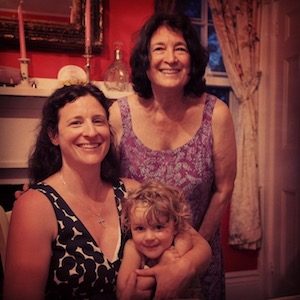
Oh, the marvels my daughter can do! Happy Mother’s Day, Sam!